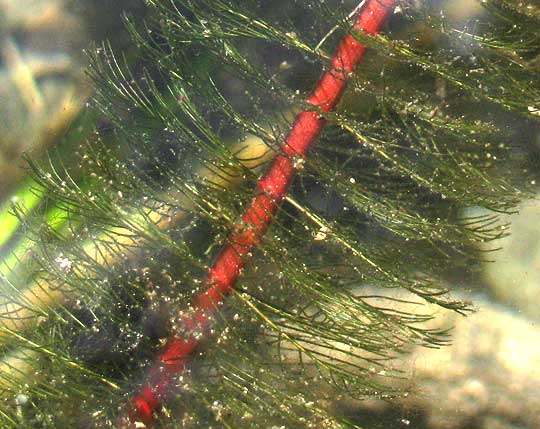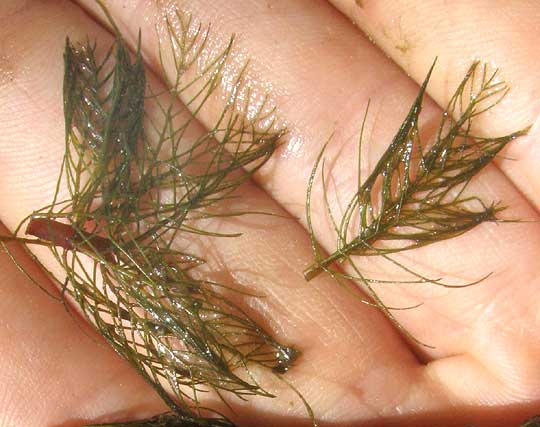Excerpts from Jim Conrad's
Naturalist Newsletter

from the October 21, 2012 Newsletter issued from the valley of the Dry Frio River in northern Uvalde County, southwestern Texas, on the southern border of the Edwards Plateau; elevation ~1750m (~5750 ft); N29.62°, W99.86°; USA
VARIABLE-LEAF WATERMILFOIL
Most of the little Dry Frio River behind the cabin is only ankle deep and the submerged limestone pebbles or bedrock are coated with a pale kind of loose, lime-rich mud that's very slippery. However, here and there waist-deep pools of clear water occur and sometimes interesting aquatic plants and animals take up residence in these pools. That's the case at a certain swimming hole where a frayed, yellow swinging-rope dangles from the limb of an overhanging Sycamore. At the edge of this tranquil pool there's a picturesque colony of submerged, leg-long, three-finger-wide aquatic plants with their wormlike bodies slowly undulating in the weak current and their tips pointed downstream, as shown above.
Some of the underwater stems approach the bank close enough for you to see their whorls of green, feathery leaves arising from thick, succulent, reddish stems, as shown below:

If you pluck at the stem, it fragments easily. You can see a stem fragment with detached leaves in my hand below:

In this year's May 27 Newsletter we profiled a similar aquatic choking a ditch in bottomland Mississippi. That was Parrotfeather, Myriophyllum aquaticum, native to the Amazon River Basin but now a serious aquatic weed in much of the world with warmer weather. You can see how it's similar, but different, from what we have here at http://www.backyardnature.net/n/h/parrot-f.htm.
Our Texas plant is a member of the same genus as Parrotfeather, but it's a different species, and it's native to the US Southeast, from Florida to Texas. It's MYRIOPHYLLUM HETEROPHYLLUM, variously known as the Variable-leaf Watermilfoil, Two-leaved Watermilfoil, also as Parrotfeather, and by other names as well. It's a member of the Watermilfoil Family, the Haloragaceae.
The watermilfoils, or genus Myriophyllum, embrace about 69 species of freshwater aquatic plants. Six or so species can be found in Texas, and in some lakes, streams and irrigation canals different species are causing problems by choking waterways. Three species in North America are considered serious invasives. Our Brazilian Parrotfeather in Mississippi was one of them, and our peaceful-looking Dry Frio watermilfoil, despite being native here, is another.
The problem is that in recent years Variable-leaf Watermilfoil has extended its distribution area northward, maybe helped along by global warming. A website based in New England, where it wasn't noticed until 1932, says that it can "... completely congest waterways and crowd out other species of aquatic plants. It also hinders recreational activities such as boating, swimming and fishing. The dense growth that forms also provides breeding areas for mosquitoes and degrades the quality of the water for fish and other aquatic wildlife."
State governments differ in their opinions about Variable-leaf Watermilfoil. In Ohio and Pennsylvania it's listed as Endangered, but in Vermont it's listed as a Class A noxious weed, and in Massachusetts and Connecticut it's banned.
However, down at the swimming hole below the cabin, the Bluegill fish seem to love the environment the plant creates, hiding among its slowly undulating stems, nibbling at snails and other tiny critters on its stems and leaves.